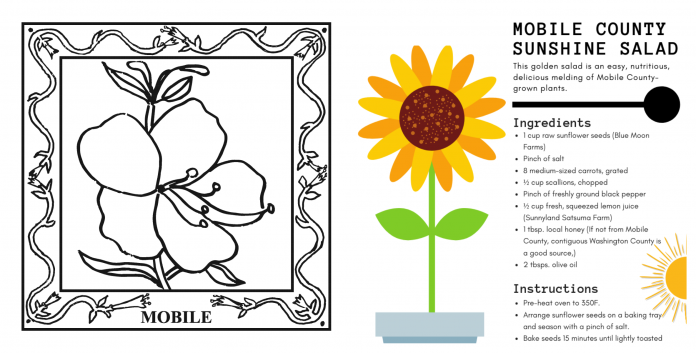The Alabama honeysuckle border was inspired by an 18th century, Southern applique quilt.
The Cullman Tribune is celebrating the Alabama Bicentennial (1819-2019) with statewide field reporting by Alabama Master Gardener/Botanical Artist Ben Johnson South. This year-long feature, "The 67-County Alabama Garden Party," will spotlight different counties each week. Each county will get its own "quilt block," along with a historical profile, and we'll share a recipe specific to the area. At the end of the year, all 67 counties will be put in a book to commemorate the Bicentennial.
Mobile County
I’m writing this on St. Valentine’s Day which is fitting since Mobile is consistently voted one of the most romantic places in North America. Mobile is inarguably Alabama’s most popular, garden city and a splendid place to explore horticulture and heritage.
Mobile was established by French explorers in 1702 who crowned it the capital of “New France” (La Louisiane). In less than two years, these seductive Frenchmen enticed a boatload of 23 adventurous Frenchwomen to sail across the ocean and join them. Bliss comes in waves down here. The ladies arrived on a ship named “The Pelican” and were warmly welcomed on shore by eager suitors carrying bouquets of native flowers. “The Pelican Girls,” as they were called, which would make a winning name for a Mobile softball team or a rock band, beautifully changed American history forever. Or, as Mobilians say in their molasses-sweetened drawl, “fo-evvvvv-vuh.”
Mobile is the largest metropolis on the Gulf Coast between New Orleans, two hours west and St. Petersburg, Florida seven hours, on a good day, east. It’s the only saltwater port in Alabama and the 12th largest in the U.S.
As Audrey Hepburn said about Paris, “Mobile is always a good idea.” It’s a desired location for romantic flings, destination weddings and lots of impromptu joie de vivre. Romance still lingers in the perfumed air. This city on the bay and surrounding Mobile County is a time-weaving treasure with one foot comfortably in an 18th century dancing slipper and the other foot in an aerospace, lunar-landing boot. Mobile has both charm and innovation.
As for PLANTS + PEOPLE in Mobile County, the rich soil and the shirt-stuck-to-your back humidity mean a readymade, 1,400-square-mile greenhouse environment. Local tall tale tellers, and there are many, say you can’t leave a baby on a blanket in the yard because the wisteria grows so fast, little ones and lollygaggers are at risk of being pinned down by the pretty, purple-flowered vines.
Mobile County farm markets are bustling and blissful, but nobody here is in a hurry. The growers are just pleased as punch that you are stopping to smell the fresh mint, muskmelons and peppers. You’ll find more Alabama-grown cut flowers here than in most markets in the state, tall cylinders of lilies and gallon jugs of bold zinnias. Boxed crates of thriving annuals like clove-scented dianthus and begonias stretch into the distance.
Mobile gastronomy is centuries of French-influenced cuisine married to fresh, local produce. It’s delightful. It’s delectable. It’s often divinely decadent. Mobile Catholics gave America the first Mardi Gras, the annual holiday of indulgence which precedes weeks of slightly more restrained Lent. That said, even the Lenten lunches at the many churches and cathedrals around Mobile County amuse bouche ( “amuse the mouth”) as the locals say.
The people part of the PLANTS + PEOPLE combination in Mobile County is one of my favorite pleasures every time I visit. There is relaxed, hospitable diversity in this old, Southern place. The port was a trading post for French and Native Americans in the gulf region. In 1763, the first permanent Jewish settlers came to Mobile, creating businesses as merchants and in warehousing. Huge cotton and sugar plantation economies in the area relied on enslaved labor. (An 1850s census reports one-fourth of the county’s population were slaves, mostly of African origin.) Creole culture thrived. People from all over the world arrived, and many stayed. This blending of cultures is the reason Mobile food is so complex and intriguing: the French sauces, the fried cooking techniques of Africa, the vegetable traditions of Great Britain, the Creole sausage and gumbos, the Spanish and Caribbean spices. This gently-tossed cultural salad also makes for a colorful, delightful, beautifully diverse population.
One of Mobile’s most colorful characters, Eugene Ferdinand Walter, Jr., was first cousin of a friend of mine. Eugene Walter wore many hats. He was a movie screenwriter, poet, puppeteer, gourmet chef, cryptographer, translator for Fellini films, costume designer and like every other Mobilian, a great raconteur. A favorite tidbit I was told about Cousin Eugene is during his years in Europe, he kept a shoebox of Mobile County red soil so he could remain connected to his roots. After a jazz funeral parade, Eugene Walter was laid to rest a few years ago in Mobile’s Church Street Graveyard which had been closed since the 1890s. When you visit him under the magnolias dripping with Spanish moss, notice all the marble and granite tombstones carved with rosettes, floral-motifs and sugarcane branches. This is a glorious garden for the afterlife. (Enjoy the documentary film “Eugene Walter: Last of the Bohemians” by Robert Clem.)
About his beloved home county, impish Eugene Walter wrote this as high praise: “Down in Mobile we’re all crazy because the Gulf Coast is the land of clowns, ghosts and musicians. Mobile is Sweet Lunacy’s county seat.”
I asked some other pleasure-seeking Mobilians for their suggestions on how to celebrate PLANTS + PEOPLE in their county. Here are their passionate replies and a shared recipe for Mobile County Sunshine Salad:
*EAT LUNCH AL FRESCO—Mobile has more outside dining than any other place in Alabama; time studies indicate Mobilians enjoy a slightly longer, more gracious, “slow food” lunch, and this includes bosses; everybody raves about A Spot Of Tea and my friend, Greg Burden, says this charming eatery has a couple of chairs waiting for you in the park outside.
*FASHION, ART & FLOWERS—Julia Greer Fobes and her sister, Betsy, are the “go-to” genies for special event flowers in Mobile; they design all-things-Mardi Gras including the robes for king, queen and court; Julia, a costume and theater set designer at Ole Miss, can magically transform even wallflowers to wonderful. Check out her Facebook page for photos of her swoon-inducing , opulent flower arrangements laden with local botanicals.
*KAYAK AT 5 RIVERS DELTA RESOURCE CENTER—Actually, I plan to rent a row boat and a rower and entice gifted, delightful, Mobile artist, Mary Elizabeth Kimbrough to paint the local flowers as Monet did on the Seine while I mix us garden-to-glass coolers and enjoy the natural beauty along the Apalachee, Blakeley, Mobile, Spanish and Tensaw Rivers.
*THE MILLIE McCONNELL RHODODENDRON GARDEN – at the superb, Mobile Botanical Garden; also save time for the 30-acre Longleaf Pine Habitat.
*BELLINGRATH GARDENS—Sixty-five glorious acres of native and immigrant azaleas and other grand plantings; also, enjoy the decorative arts, many with floral and nature embellishments in the 1930s mansion.
*FORTY-FIVE PUBLIC PARKS IN MOBILE CITY LIMITS—There are plants and gardens for every adult and child’s particular tastes; some gardens are tranquil and hushed and others are pulsing with cosmopolitan urbanity, all FREE and OPEN TO THE PUBLIC.
*BROWN FURNITURE (That’s what Old Mobile locals call fine mahogany and other woods)— Charles Phillips Antiques and Architecturals in Theodore- exquisite finds, some locally-made: www.charlesphillipsantiques.com.
*BOULANGERIES AND PATISSERIES—Alabama has many great pie shops and bakeries, but remember Mobile has three centuries of summers where Francophile bakers have triumphed to keep croissants flakey and not “sogged up” in the sub-tropical humidity. I hear raves about the made-from-scratch goodies at Bake My Day; ask them which delicacies are made from Granny Sims’ home recipes and sample the classically Southern, Red Velvet Cake and a Mobile classic, Praline Pound Cake.
*CHILDREN’S GARDEN ENTRANCE—This unique design at the University of South Alabama Children’s and Women’s Hospital shows how part of the world adds a note of pleasure even during life’s most-troubling moments.
*THE RABBIT HOLE AT WONDERLAND CAFÉ—This new hidden pleasure-dome has “curious eats and whimsical treats” like bubble tea, all inspired by the Lewis Carroll garden of “Alice In Wonderland” (Piccadilly Square/Mobile); it’s delightfully garden-y for children of all ages.
*AZALEA TRAIL—It’s a classic, springtime drive through 35 miles of staggeringly gorgeous floral grandiosity.
*AZALEA TRAIL MAIDS—Mobile County’s official ambassadors are meant to be the embodiment of ideals; only 50 are chosen each year from the county high schools; their extravagant and radiantly colored, Antebellum-inspired gowns are designed to transform them into sweetly swaying flower blossoms.
*AVENUE OF OAKS (SPRINGHILL COLLEGE)—Regardless of your school allegiance, this grande allee will make you cheer for the landscape visionaries who created a wondrous promenade for your pleasure- great biking- also, while you’re in the vicinity, saunter with the local flâneurs to Carpe Diem, the regional favorite coffee and baked goods shop.
*LOCAVORES’ FAVORITE RESTAURANT—Many Mobile-area chefs are the first to greet their favorite Mobile County farmers at the markets; one much-lauded locavore magnet is The Noble South where community-minded Chef Chris Rainasek is putting Mobile County produce on a high-profile pedestal.
*MOBILE COUNTY FARMERS’ MARKETS—Citronelle Farmers’ Market (May-August), Dauphin Island Farmers’ Market (April-July), Market in the Park (Cathedral Square/Lavretta Park), Prichard Farmers’ Market (year round, first and third Saturdays), Trifit Farmers’ Market (Providence Hospital/Mobile)
*MOBILE COUNTY U-PICK PLANT FARMS—Betty’s Berry Farm, Blue Moon Farm, Chickasabogue Vineyard (Chunchula, for scuppernongs and muscadines), Ken Buck Farm (Irvington), Powell Blueberry Farm (Citronelle), Sunnyland Satsuma Farm (Mobile for satsumas, lemons)
*BEST GARDEN-TO-GLASS CRAFT COCKTAILS—The Haberdasher (those in the know call it “The Hab”) has an inventive mixologist who lives to muddle and tease locally-sourced herbs and spices into award-winning, cooling concoctions; try the Kentiki (Kentucky Bourbon storms the Tiki hut).
*JAIL WARDEN/SCULPTOR—Trey Oliver, a talented driftwood artisan and jailer deserves his own reality television show.
*THE LOST GARDEN—Plant explorers head to this “secret site” on the south side of Dauphin Street between Jackson and Joachim.
*FESTIVAL OF FLOWERS—Held at Providence Hospital; it’s an 8-acre, annual flower extravaganza and plant sale which is one of “THE TOP 20 EVENTS” in the region according to the Southern Tourism Council; this year’s salute is the glory of “Dutch Gardens” on March 21-24; think of the beauty and creativity of the Royal Chelsea Flower Show (London), with better food.
*BEST PLACE TO TAKE A BOTANICAL PHOTOGRAPHER/ARTIST—Let them capture the glistening resurrection ferns on the live oaks along Government Street after a gentle rain.
*RED BEANS AND RICE—Even with all the 21st century beaneries in Mobile, I’d still go to Wintzell’s; they’ve had a pot of red beans and rice simmering since Hank Aaron was in Little League and may have welcomed “The Pelican Girls” with a warm bowl.
*HAMMERIN’ HANK AARON—“The Home Run Champion of all Time” grew up in Toulminville (Mobile County) and preferred the Louisville Slugger (A99) wooden bat. One of the nicest and most genuine celebrities I’ve ever interviewed, Hank Aaron credits his Mobile roots for his “awe, shucks” modesty and world-class charm.
*PLANTING AN IDEA—Mobile County is the perfect location to create an Alabama Garden of Romance. This could be inspired by the rose garden of French Empress Josephine at Malmaison, which she immortalized by recruiting renowned, botanical artist, Pierre-Joseph Redoute’ to paint each treasured flower specimen. Empress Josephine was born on the Caribbean island of Martinique, so she knew which roses could thrive in Mobile’s moist climate; garden historians note Mobile’s 19th century commercial nurseries sold expensive, treasured, rose bushes which touted Malmaison provenance. I’m imagining large, public paintings of the Redoute’ roses and recreating the Empress Josephine’s “X” garden design similar to the Alabama state flag. Maybe add hurricane lamps, romantic lighting, seats and swings for two, and strolling violinists or easy-listening jazz (Mobile has music everywhere).
Y’ALL COME to Mobile County on your 67-COUNTY, ALABAMA GARDEN PARTY tour through this “state within a garden.”
MOBILE COUNTY SUNSHINE SALAD
This golden salad is an easy, nutritious, delicious melding of Mobile County-grown plants.
INGREDIENTS
- 1 cup raw sunflower seeds (Blue Moon Farms)
- Pinch of salt
- 8 medium-sized carrots, grated
- ½ cup scallions, chopped
- Pinch of freshly ground black pepper
- ½ cup fresh, squeezed lemon juice (Sunnyland Satsuma Farm)
- 1 tbsp. local honey (If not from Mobile County, contiguous Washington County is a good source,)
- 2 tbsps. olive oil
DIRECTIONS
- Pre-heat oven to 350F.
- Arrange sunflower seeds on a baking tray and season with a pinch of salt.
- Bake seeds 15 minutes until lightly toasted (turn every 5 minutes).
- Whisk the dressing ingredients (lemon juice, salt, pepper, honey, olive oil) in a small bowl.
- Place carrots and scallion in a bowl with the dressing and mix well.
- Add sunflower seeds and mix again.
Serves 6
Also, check out Alabama Bicentennial: 200 ways to save Alabama for the next 200 years.
Copyright 2019 Humble Roots, LLC. All Rights Reserved.




























